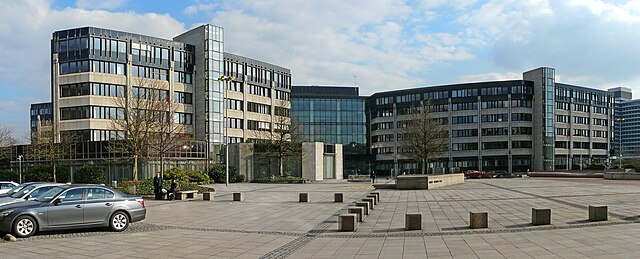Federal Ministry for Digital and Transport
Cabinet-level ministry in Germany From Wikipedia, the free encyclopedia
The Federal Ministry for Digital and Transport (German: Bundesministerium für Digitales und Verkehr, pronounced [ˈbʊndəsminɪsˌteːʁiʊm fyːɐ̯ diɡiˈtaːləs ʊnt fɛɐ̯ˈkeːɐ̯] ), abbreviated BMDV, is a cabinet-level ministry of the Federal Republic of Germany. Its main office is located in Berlin, while the majority of its civil servants and employees work in Bonn, the secondary seat.
| Bundesministerium für Digitales und Verkehr (BMDV) | |
 | |
 | |
| Agency overview | |
|---|---|
| Formed | 20 September 1949 |
| Jurisdiction | Government of Germany |
| Headquarters | Invalidenstraße 44, Berlin 52°31′46.58″N 13°22′42.10″E |
| Employees | 1,300 |
| Annual budget | €41.154 billion (2021)[1] |
| Minister responsible |
|
| Website | http://www.bmdv.bund.de |

The Ministry itself has about 1300 employees. At the top is the Federal Minister, and there are two Parliamentary Secretaries, who are also Member of the Bundestag, and two civil servant undersecretaries. The ministry oversees 63 downstream agencies and authorities[2] where around 25,000 people work.[3]
The agency was formed through the merger of the former Federal Ministry of Transport and the Federal Ministry of Regional Planning, Building and Urban Development, both established in 1949. The merged ministry was at first named Federal Ministry of Transport, Building and Housing until it adopted the name Federal Ministry of Transport, Building and Urban Development (BMVBS) in 2005. On December 17, 2013, it was renamed to Federal Ministry of Transport and Digital Infrastructure (BMVI) through an organizational decree by the Merkel III Cabinet. A decree issued by Olaf Scholz upon assuming chancellorship on December 8, 2021, lead to the ministry receiving its current designation.[4]
After German reunification, politicians from the New states of Germany often headed the ministry, which had large responsibility over rebuilding the crumbling infrastructure left over from former East Germany. Günther Krause was the first minister after the 1990 German federal election and in 2002, former Minister-President of Brandenburg Manfred Stolpe was appointed, after his successor as Minister-President, then-Mayor of Potsdam Matthias Platzeck had refused the job in 1998. Stolpe was succeeded by then-Mayor of Leipzig Wolfgang Tiefensee, who had refused the job similarly to Platzeck in 2002.
Responsibilities
The ministry, together with its subordinate agencies, is responsible for all federal portfolio tasks which touch the mobility of people, goods, services and data.
The responsibilities extends to the federal transport infrastructure (Autobahn, federal motorways, railway networks, waterways and air traffic) as well as to the widespread availability of modern broadband networks across Germany. Hence, the ministry develops legal policies and ensures the safety of the modes of transport, respectively. Additionally, it ensures the seamless planning and financing of investments for maintenance and development of infrastructures.
The main focus in the field of digital infrastructure is a comprehensive supply of fast Internet with a transmission speed of at least 50 Mbps). Another task is to modernise mobility (alternative fuels, interconnected and intelligent transport system). This includes, e.g., the establishment of 'Digitales Testfeld Autobahn' to test innovative vehicle technologies. The ministry is also responsible for the Galileo satellite navigation system and the Copernicus Programme of the European Union.
Agencies
Subordinate agencies include:
- German Federal Bureau of Aircraft Accident Investigation
- Federal Bureau for Maritime Casualty Investigation
- The Federal Maritime and Hydrographic Agency (German: Bundesamt für Seeschiffahrt und Hydrographie (BSH)) located in St. Pauli, Hamburg, provides among other things information of all matters of maritime shipping, to special funding programmes, law of flag, certification of mariners and information of the coasts and coastal waters of Germany.[5]
- German Federal Highway Research Institute (German: Bundesanstalt für Straßenwesen (BASt))[6] located in purpose built facilities in Bergisch Gladbach since 1983, with a focus on aspects of road engineering. Its mission is the improvement of safety, environmental compatibility, efficiency and performance relating to roads.
Federal Ministry of Transport and Digital Infrastructure
See also
References
External links
Wikiwand in your browser!
Seamless Wikipedia browsing. On steroids.
Every time you click a link to Wikipedia, Wiktionary or Wikiquote in your browser's search results, it will show the modern Wikiwand interface.
Wikiwand extension is a five stars, simple, with minimum permission required to keep your browsing private, safe and transparent.
